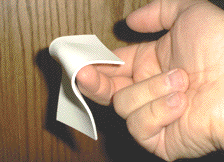Working with
Sintra®1
A different kind of PVC -- 14
July, 2002
|
|
|
|
|
|
|
|||
|
Sintra® is the brand name for Alusuise Composites' rigid PVC (poly vinyl chloride) foam board2, a moderately expanded, closed-cell PVC sheet. Developed in Europe in the 1970's, Sintra® was introduced to North America in 1980, and has been used primarily in signs and displays to date. Thanks to a number of useful properties, though, Sintra® and its cousins are seeing increasing attention of late from robot builders. Sintra® is available in thicknesses from 1mm to 19mm (but 3mm and 6mm are the most common), and a dozen colors (white is available in all thicknesses, the other colors just in 3mm and 6mm; more about colors later). As a result of its structure, Sintra® has a number of properties useful to BEAMers:
Where to get some Most likely you'll need to break down and actually buy material -- here, there are a couple of ways to go. Sintra® and its cousins leave the factory in sheets 4' x 8' and larger, so if you need a bigger piece than you can find in local scrap bins, but don't want to buy (much less pay shipping on) a full sheet, you'll have to work through a distributor. U.S. Plastic Corp. will sell you a quarter sheet (2' x 4') or half sheet (4' x 4') of Sintra® in your choice of many thicknesses and colors. Most likely, though, you'll want a still smaller piece than that. Both Solarbotics (with Sintra® in a variety of colors and three thicknesses) and Lynxmotion (stocking two thicknesses, in any color you like -- so long as you like yellow) will sell you 8" x 12" pieces. Cutting, machining, and forming
As a note of warning, be careful not to crush Sintra® while you're manhandling it -- crushing destroys the material's internal cell structure, leaving you with a very flexible and essentially useless mess.
Sticking pieces together
Notes: 1. Other vendors produce products comparable to Sintra®; these are sold under the brand names of Kömatex® (by Kömmerling), and Celtec® (by Vycom). Thanks to Sintra®'s market dominance, though, it's the brand name you'll most often run across, and is often (if inaccurately) used as a generic term for PVC foam board. 2. Note that when you're shopping for PVC foam board, you need to make sure you are not getting Fome-Cor®, a.k.a. "foam core," which is much softer, and essentially just paper-faced styrofoam. 3. For those who may need such
information, I've hosted a zipped copy of the
SINTRA material safety data sheet (MSDS)
here. |
|
|
|
|
|
|
|
||
|
|
This page was last updated on |
|

